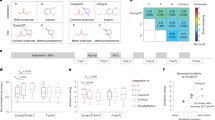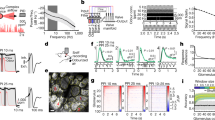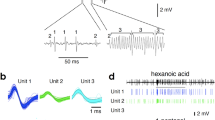Abstract
Our sense of smell is based on a remarkable chemical-detection system that possesses high sensitivity, broad discriminability and plastic, yet stable, function. Understanding how olfactory stimuli translate into perception is a problem of daunting complexity. How do odour-coding events in single cells correlate with emergent properties from the ensemble, and with behaviour? For comprehensive descriptions of neural function, analysis must extend from examination of how elemental principles relate to the function of the whole. The tiger salamander has long been used as an experimental model in studies of olfaction, enabling general questions about olfactory function to be approached.
This is a preview of subscription content, access via your institution
Access options
Subscribe to this journal
Receive 51 print issues and online access
$199.00 per year
only $3.90 per issue
Buy this article
- Purchase on Springer Link
- Instant access to full article PDF
Prices may be subject to local taxes which are calculated during checkout




Similar content being viewed by others
References
Warr, C., Clyne, P., de Bruyne, M., Kim, J. & Carlson, J. R. Olfaction in Drosophila : coding, genetics and e-genetics. Chem. Senses 26, 201–206 (2001).
Galizia, C. G., Sachse, S., Rappert, A. & Menzel, R. The glomerular code for odor representation is species specific in the honeybee Apis mellifera. Nature Neurosci. 2, 473–478 (1999).
Hildebrand, J. G. Analysis of chemical signals by nervous systems. Proc. Natl Acad. Sci. USA 92, 67–74 (1995).
Laurent, G. et al. Odor encoding as an active, dynamical process: experiments, computation, and theory. Annu. Rev. Neurosci. 24, 263–297 (2001).
Gelperin, A., Tank, D. W. & Tesauro, G. in Neural Models of Plasticity: Experimental and Theoretical Approaches (eds Byrne, J. H. & Berry, W. O.) 133–159 (Academic, 1989).
Ache, B. W. in Smell and Taste in Health and Disease (eds Getchell, T. V., Bartoshuk, L. M., Doty, R. L. & Snow, J. B.) 3–18 (Raven, New York, 1991).
Mellon, D. Jr Convergence of multimodal sensory input onto higher-level neurons of the crayfish olfactory pathway. J. Neurophysiol. 84, 3043–3055 (2000).
Sengupta, P., Chou, J. H. & Bargmann, C. I. odr-10 encodes a seven transmembrane domain olfactory receptor required for responses to the odorant diacetyl. Cell 84, 899–909 (1996).
Van Houten, J. L., Yang, W. Q. & Bergeron, A. Chemosensory signal transduction in paramecium. J. Nutr. 130, 946S–949S (2000).
Ngai, J., Dowling, M. M., Buck, L., Axel, R. & Chess, A. The family of genes encoding odorant receptors in the channel catfish. Cell 72, 657–666 (1993).
Restrepo, D., Boekhoff, I. & Breer, H. Rapid kinetic measurements of second messenger formation in olfactory cilia from channel catfish. Am. J. Physiol. 264, C906–C911 (1993).
Nikonov, A. A. & Caprio, J. Electrophysiological evidence for a chemotopy of biologically relevant odors in the olfactory bulb of the channel catfish. J. Neurophysiol. 86, 1869–1876 (2001).
Friedrich, R. W. & Korsching, S. I. Chemotopic, combinatorial, and noncombinatorial odorant representations in the olfactory bulb revealed using a voltage-sensitive transducer. J. Neurosci. 18, 9977–9988 (1998).
Revial, M. F., Sicard, G., Duchamp, A. & Holley, A. New studies on odour discrimination in the frog's olfactory receptor cells. I. Experimental results. Chem. Senses 7, 175–191 (1982).
Getchell, T. V. Analysis of unitary spikes recorded extracellularly from frog olfactory receptor cells and axons. J. Physiol. (Lond.) 234, 533–551 (1973).
Mori, K., Nagao, H. & Yoshihara, Y. The olfactory bulb: coding and processing of odor molecule information. Science 286, 711–715 (1999).
Buck, L. B. Information coding in the vertebrate olfactory system. Annu. Rev. Neurosci. 19, 517–544 (1996).
Mombaerts, P. et al. Visualizing an olfactory sensory map. Cell 87, 675–686 (1996).
Keller, A. et al. Functional organization of rat olfactory bulb glomeruli revealed by optical imaging. J. Neurosci. 18, 2602–2612 (1998).
Aroniadou-Anderjaska, V., Ennis, M. & Shipley, M. T. Dendrodendritic recurrent excitation in mitral cells of the rat olfactory bulb. J. Neurophysiol. 82, 489–494 (1999).
Wellis, D. P., Scott, J. W. & Harrison, T. A. Discrimination among odorants by single neurons of the rat olfactory bulb. J. Neurophysiol. 61, 1161–1177 (1989).
Johnson, B. A. & Leon, M. Modular representations of odorants in the glomerular layer of the rat olfactory bulb and the effects of stimulus concentration. J. Comp. Neurol. 422, 496–509 (2000).
Kauer, J. S. Salamander reference list (January 29, 2002) 〈http://www.neurosci.tufts.edu〉 (2002).
Kauer, J. S. Response Properties of Single Olfactory Bulb Neurons Using Odor Stimulation of Small Nasal Areas in the Salamander. Thesis, Univ. Pennsylvania (1973).
Penrose, R. in Nature's Imagination: The Frontiers of Scientific Vision (ed. Cornwell, J.) 12–26 (Oxford Univ. Press, Oxford, 1995).
Amoore, J. E. The sterochemical theory of olfaction. I. Identification of the seven primary odours. Proc. Sci. Sect. Toilet Goods Assoc. 37, 1–12 (1962).
Kauer, J. S. & White, J. Imaging and coding in the olfactory system. Annu. Rev. Neurosci. 24, 963–979 (2001).
Beets, M. G. J. The molecular parameters of olfactory response. Pharm. Rev. 22, 1–34 (1970).
Polak, E. H. Multiple profile-multiple receptor site model for vertebrate olfaction. J. Theoret. Biol. 40, 469–484 (1973).
Alkasab, T. K. et al. Characterizing complex chemosensors: information theoretic analysis of olfactory systems. Trends Neurosci. 22, 102–108 (1999).
Alkasab, T. K., White, J. & Kauer, J. S. A computational system for simulating and analyzing arrays of biological and artificial sensors. Chem. Senses 27, 261–275 (2002).
Lancet, D., Sadovsky, E. & Seidemann, E. Probability model for molecular recognition in biological receptor repertoires: significance to the olfactory system. Proc. Natl Acad. Sci. USA 90, 3715–3719 (1993).
Stopfer, M., Bhagavan, S., Smith, B. H. & Laurent, G. Impaired odour discrimination on desynchronization of odour-encoding neural assemblies. Nature 390, 70–74 (1997).
Malnic, B., Hirono, J., Sato, T. & Buck, L. B. Combinatorial receptor codes for odors. Cell 96, 713–723 (1999).
Touhara, K. et al. Functional identification and reconstitution of an odorant receptor in single olfactory neurons. Proc. Natl Acad. Sci. USA 96, 4040–4045 (1999). [Published erratum in Proc. Natl Acad. Sci. USA 97, 3782 (2000).]
Duchamp-Viret, P. & Duchamp, A. Odor processing in the frog olfactory system. Prog. Neurobiol. 53, 561–602 (1997).
Firestein, S., Picco, C. & Menini, A. The relation between stimulus and response in olfactory receptor cells of the tiger salamander. J. Physiol. 468, 1–10 (1993).
Getchell, T. V. & Shepherd, G. M. Responses of olfactory receptor cells to step pulses of odour at different concentrations in the salamander. J. Physiol. (Lond.) 282, 521–540 (1978).
Kauer, J. S. in Olfaction and Taste Vol. VII (ed. van der Starre, H.) 227–236 (IRL Press, London, 1980).
Hildebrand, J. G. & Shepherd, G. M. Mechanisms of olfactory discrimination: converging evidence for common principles across phyla. Annu. Rev. Neurosci. 20, 595–631 (1997).
Leinders-Zufall, T. et al. Ultrasensitive pheromone detection by mammalian vomeronasal neurons. Nature 405, 792–796 (2000).
Kaissling, K. E., Hildebrand, J. G. & Tumlinson, J. H. Pheromone receptor cells in the male moth Manduca sexta. Arch. Insect Biochem. Physiol. 10, 273–279 (1989).
Adrian, E. D. Sensory messages and sensation. The response of the olfactory organ to different smells. Acta Physiol. Scand. 29, 5–14 (1953).
Gesteland, R. C., Lettvin, J. Y. & Pitts, W. H. Chemical transmission in the nose of the frog. J. Physiol. (Lond.) 181, 525–559 (1965).
Maturana, H. R., Lettvin, J. Y., McCullogh, W. S. & Pitts, W. H. Anatomy and physiology of vision in the frog. J. Gen. Physiol. 43 (Suppl.), 129–175 (1960).
Graziadei, P. P. C. & Monti-Graziadei, G. A. in Handbook of Sensory Physiology Vol. 9 (ed. Jacobson, M.) 55–83 (Springer, New York, 1978).
Simmons, P. A. & Getchell, T. V. Neurogenesis in olfactory epithelium: loss and recovery of transepithelial voltage transients following olfactory nerve section. J. Neurophysiol. 45, 516–528 (1981).
Herrick, C. J. The Brain of the Tiger Salamander (Univ. Chicago Press, Chicago, 1948).
Malacinski, G. M. & Borland, S. J. The Indiana University axolotl colony 〈http://www.indiana.edu/~axolotl/〉 (2002).
Voss, S. R. & Parichy, D. Salamander genome project 〈http://lamar.colostate.edu/~srvoss/SGP/index.shtml〉 (2002).
Firestein, S. & Werblin, F. S. Odor-induced membrane currents in vertebrate olfactory receptor neurons. Science 244, 79–82 (1989).
Firestein, S., Zufall, F. & Shepherd, G. M. Single odor-sensitive channels in olfactory receptor neurons are also gated by cyclic nucleotides. J. Neurosci. 11, 3565–3572 (1991).
Kauer, J. S. Response patterns of amphibian olfactory bulb neurones to odour stimulation. J. Physiol. (Lond.) 243, 695–716 (1974).
Kauer, J. S. & Moulton, D. G. Responses of olfactory bulb neurones to odour stimulation of small nasal areas in the salamander. J. Physiol. (Lond.) 243, 717–737 (1974).
Kauer, J. S. & Shepherd, G. M. Olfactory stimulation with controlled and monitored step pulses of odor. Brain Res. 85, 108–113 (1975).
Hamilton, K. A. & Kauer, J. S. Intracellular potentials of salamander mitral/tufted neurons in response to odor stimulation. Brain Res. 338, 181–185 (1985).
Wellis, D. P. & Kauer, J. S. GABAa and glutamate receptor involvement in dendrodendritic synaptic interactions from salamander olfactory bulb. J. Physiol. 469, 315–339 (1993).
Zhao, H., Dibello, P., Carlson, J. & Firestein, S. PCR amplification of odor receptor cDNA from individual olfactory neurons in salamander. AChemS Abstr . (1994).
Firestein, S., Shepherd, G. M. & Werblin, F. S. Time course of the membrane current underlying sensory transduction in salamander olfactory receptor neurones. J. Physiol. (Lond.) 430, 135–158 (1990).
Kauer, J. S. Real-time imaging of evoked activity in local circuits of the salamander olfactory bulb. Nature 331, 166–168 (1988).
Kauer, J. S., Neff, S. R., Hamilton, K. A. & Cinelli, A. R. in Olfaction as a Model System for Computational Neuroscience (eds Davis, J. & Eichenbaum, H.) 43–68 (MIT Press, Cambridge, MA, 1991).
Cinelli, A. R., Hamilton, K. A. & Kauer, J. S. Salamander olfactory bulb neuronal activity observed by video-rate voltage-sensitive dye imaging. III. Spatio-temporal properties of responses evoked by odorant stimulation. J. Neurophysiol. 73, 2053–2071 (1995).
Cinelli, A. R. & Kauer, J. S. Salamander olfactory bulb neuronal activity observed by video-rate voltage-sensitive dye imaging. II. Spatio-temporal properties of responses evoked by electrical stimulation. J. Neurophysiol. 73, 2033–2052 (1995).
White, J. & Kauer, J. S. Exploring olfactory population coding using an artificial olfactory system. Prog. Brain Res. 130, 191–203 (2001).
Spors, H. & Grinvald, A. Spatio-temporal dynamics of odor representations in the mammalian olfactory bulb. Neuron 34, 301–315 (2002).
Uchida, N., Takahashi, Y. K., Tanifuji, M. & Mori, K. Odor maps in the mammalian olfactory bulb: domain organization and odorant structural features. Nature Neurosci. 3, 1035–1043 (2000).
Rubin, B. D. & Katz, L. C. Optical imaging of odorant representations in the mammalian olfactory bulb. Neuron 23, 499–511 (1999).
Meister, M. & Bonhoeffer, T. Tuning and topography in an odor map on the rat olfactory bulb. J. Neurosci. 21, 1351–1360 (2001).
Kent, P. F. & Mozell, M. M. The recording of odorant-induced mucosal activity patterns with a voltage-sensitive dye. J. Neurophysiol. 68, 1804–1819 (1992).
Mason, J. R. & Stevens, D. A. Discrimination and generalization among reagent grade odorants by tiger salamanders (Ambystoma tigrinum). Physiol. Behav. 26, 647–653 (1981).
Dorries, K. M., White, J. & Kauer, J. S. Rapid classical conditioning of odor response in a physiological model for olfactory research, the tiger salamander. Chem. Senses 22, 277–286 (1997).
Dawley, E. M. in Chemical Signals in Vertebrates 4: Ecology, Evolution, and Comparative Biology (eds Duvall, D., Muller-Schwarze, D. & Silverstein, R. M.) 221–224 (Plenum, New York, 1986).
Lindquist, S. B. & Bachmann, M. D. The role of visual and olfactory cues in the prey catching behavior of the tiger salamander, Ambystoma tigrinum. Copeia 1, 81–90 (1982).
Leinders-Zufall, T., Greer, C. A., Shepherd, G. M. & Zufall, F. Imaging odor-induced calcium transients in single olfactory cilia: specificity of activation and role in transduction. J. Neurosci. 18, 5630–5639 (1998).
Lowe, G. & Gold, G. H. Contribution of the ciliary cyclic nucleotide-gated conductance to olfactory transduction in the salamander. J. Physiol. 462, 175–196 (1993).
Kauer, J. S. Olfactory receptor cell staining using horseradish peroxidase. Anat. Rec. 200, 331–336 (1981).
Kauer, J. S. in Neurobiology of Taste and Smell (eds Finger, T. E. & Silver, W. L.) 205–231 (Wiley, New York, 1987).
Halasz, N. & Greer, C. A. Terminal arborizations of olfactory nerve fibers in the glomeruli of the olfactory bulb. J. Comp. Neurol. 337, 307–316 (1993).
Christensen, T. A. & White, J. in The Neurobiology of Taste and Smell (eds Finger, T. E., Silver, W. L. & Restrepo, D.) 197–228 (Wiley-Liss, New York, 2000).
Laurent, G. A systems perspective on early olfactory coding. Science 286, 723–728 (1999).
Rall, W. & Shepherd, G. M. Theoretical reconstruction of field potentials and dendrodendritic synaptic interactions in the olfactory bulb. J. Neurophysiol. 31, 884–915 (1968).
Freeman, W. J. & Baird, B. Relation of olfactory EEG to behavior: spatial analysis. Behav. Neurosci. 101, 393–408 (1987).
Freeman, W. J. The physiology of perception. Sci. Am. 264, 78–85 (1991).
White, J., Hamilton, K. A., Neff, S. R. & Kauer, J. S. Emergent properties of odor information coding in a representational model of the salamander olfactory bulb. J. Neurosci. 12, 1772–1780 (1992).
Scott, J. W., Brierley, T. & Schmidt, F. H. Chemical determinants of the rat electro-olfactogram. J. Neurosci. 20, 4721–4731 (2000).
Zou, Z., Horowitz, L. F., Montmayeur, J.-P., Snapper, S. & Buck, L. B. Genetic tracing reveals a stereotyped sensory map in the olfactory cortex. Nature 414, 173–179 (2001).
Slotnick, B. M., Bell, G. A., Panhuber, H. & Laing, D. G. Detection and discrimination of propionic acid after removal of its 2-DG identified major focus in the olfactory bulb: a psychophysical analysis. Brain Res. 762, 89–96 (1997).
Hudson, R. From molecule to mind: the role of experience in shaping olfactory function. J. Comp. Physiol. A 185, 297–304 (1999).
Kauer, J. S. Contributions of topography and parallel processing to odor coding in the vertebrate olfactory pathway. Trends Neurosci. 14, 79–85 (1991).
Acknowledgements
Work described in this paper has been generously supported by grants from the NIH (NIDCD), the Office of Naval Research, and the Defense Advanced Research Projects Agency. The studies on the olfactory pathway arising from work in my laboratory have been carried out by many highly skilled, insightful colleagues, including K. Hamilton, A. Cinelli, M. Schwartz Levey, J. White, D. Wellis, K. Dorries, T. Bozza, J. Marchand, T. Alkasab and M.-C. Cheung. I thank B. Talamo and J. White for helpful suggestions on the manuscript.
Author information
Authors and Affiliations
Corresponding author
Rights and permissions
About this article
Cite this article
Kauer, J. On the scents of smell in the salamander. Nature 417, 336–342 (2002). https://doi.org/10.1038/417336a
Issue Date:
DOI: https://doi.org/10.1038/417336a
This article is cited by
-
Olfaction across the water–air interface in anuran amphibians
Cell and Tissue Research (2021)
-
Pheromonal communication in urodelan amphibians
Cell and Tissue Research (2021)
-
Pheromonal communication in amphibians
Journal of Comparative Physiology A (2010)
-
Three-dimensional antennal lobe atlas of the oriental fruit moth, Cydia molesta (Busck) (Lepidoptera: Tortricidae): comparison of male and female glomerular organization
Cell and Tissue Research (2009)
-
From biomedicine to natural history research: EST resources for ambystomatid salamanders
BMC Genomics (2004)
Comments
By submitting a comment you agree to abide by our Terms and Community Guidelines. If you find something abusive or that does not comply with our terms or guidelines please flag it as inappropriate.




